Netherlands Resume Formats, Templates, and Writing Tips
Applying for a job in the Netherlands? This Netherlands resume guide has the templates, tips, examples, & format requirements needed to write the perfect resume.
If you want to land a job in the Netherlands, you need to learn how to write a Netherlands resume. It’s important to make sure your resume has all the right personal details, the right structure, and the right sections.
Whether you are already living in the Netherlands, or you plan to find employment there in the future, you need to write a resume that will land you an interview. This article will address:
- Netherlands resume formats and how to select the right one for you
- Netherlands resume requirements
- How to write a Netherlands resume
- Netherlands resume tips
- Netherlands resume FAQs
Before getting started, you may want to try out VisualCV’s resume-building platform: the best way to build a Netherlands resume.
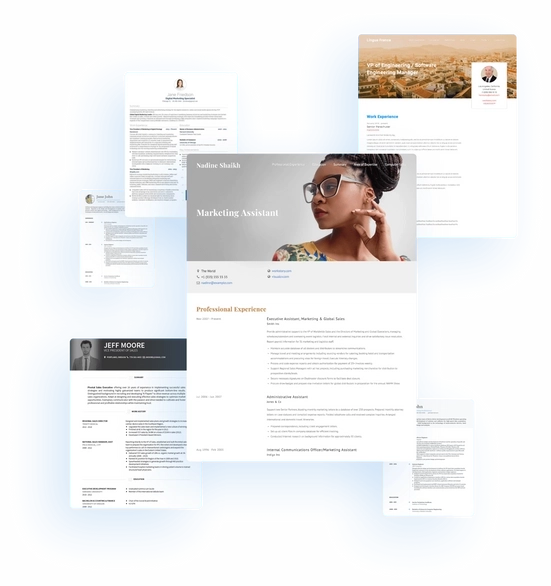
Netherlands Resume Requirements
While writing a clear and compelling resume is important, first you need to include all the right basic information that Dutch employers expect.
When writing your Netherlands resume, be sure to include your:
- Name
- Phone number
- Email address
- Home address
It is also recommended to include:
- Photo
- Date of birth
Optionally, you may include:
- Nationality
- Marital status
- Military obligations
In the body of the resume, your resume should include these sections:
- Summary
- Work experience
- Education
- Skills
- Extracurriculars
Netherlands Resume Tips and FAQs
Writing a Netherlands resume can be tough, especially if you’re writing one for the first time. For this reason, we have collected this list of Netherlands resume tips and FAQs to help you get started. These questions will help you write a great resume that lands you a career in the Netherlands.
What is the right format for a Netherlands resume?
There are three potential formats you can use when writing a Netherlands resume: Reverse-chronological, Functional, and Combination.
Reverse Chronological Netherlands Resume Format Example
The reverse-chronological resume lists past jobs in reverse-chronological order, beginning with your most recent position at the top of the resume and working backwards. In a reverse-chronological resume, your Work Experience section is the largest and most detailed part of the resume. Your skills and education are secondary.
This is the most common Netherlands resume format, and the one most job-seekers should use. This format provides the best timeline of your career, and gives employers the information they want in the order they expect it.
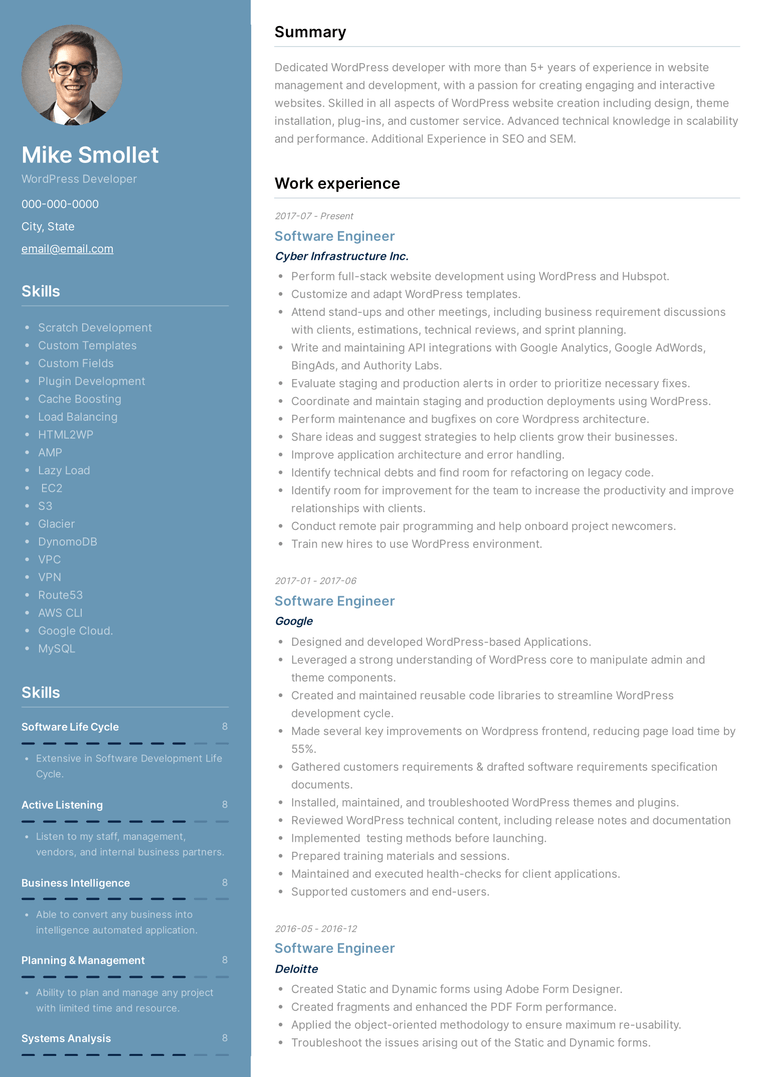
Functional Netherlands Resume Format Example
A functional resume focuses on skills instead of work experience. In a functional resume, you include a large Skills section, with descriptions and examples for each skill area, above the Work Experience section. The Work Experience section is shorter and less detailed, and jobs are ordered by relevance rather than chronology.
Functional resumes are rare. If you want to write a resume that highlights skills instead of work experience, we recommend a combination resume.
Combination Netherlands Resume Format Example
A combination resume format combines aspects of the reverse-chronological and functional resume formats. In a combination resume, skills are emphasized over work history, but previous roles in the Work Experience section are still listed in reverse-chronological order. This allows you to draw attention to your skill set, but maintains a clear career timeline so employers can easily understand which jobs were most recent.
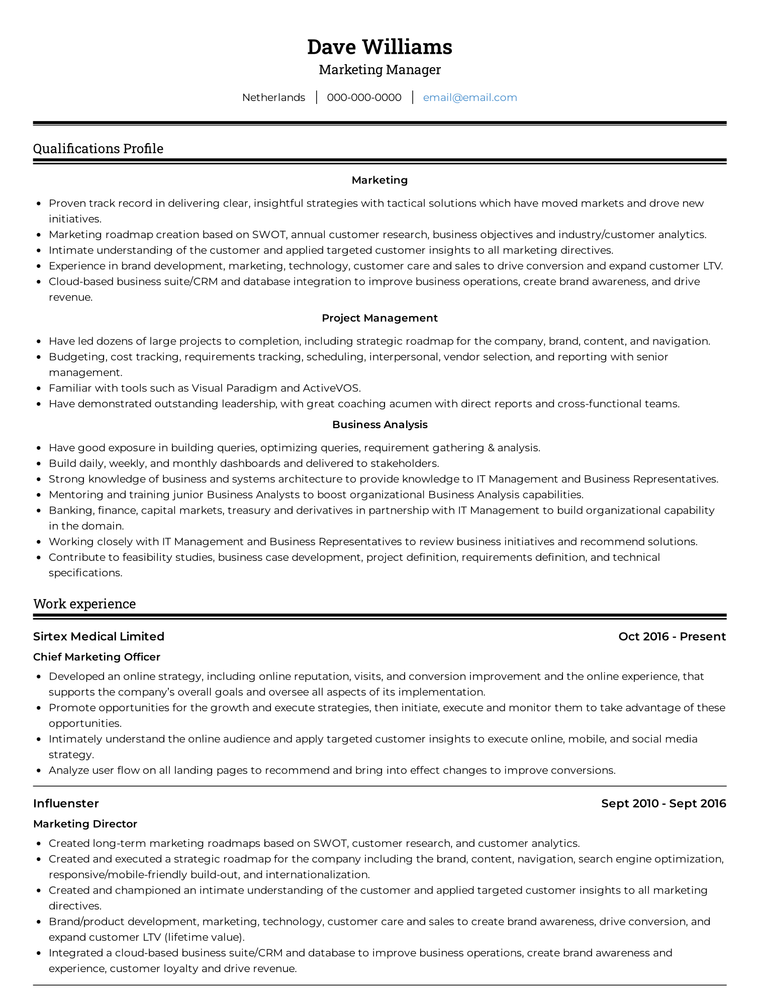
Choosing a resume format
The resume format you choose for your Netherlands resume will depend on your career and the job you are applying to.
If you have had a typical career, with the bulk of your previous jobs belonging to the same industry, each one leading logically to the next, a reverse-chronological resume is the best choice. This is the most common resume format, and the one most employers expect.
If you have had an untraditional career, with lots of career changes or gaps, you may want to try a combination resume format. This way, you can make sure all of your skills are on display right at the top of your resume, and hiring managers won’t have to wade through your past jobs to see what your abilities are.
When in doubt, however, the reverse-chronological resume is the way to go.
What is the right Netherlands resume length?
Your Netherlands resume should be one or two pages long, using A4 paper.
If you can fit all of your qualifications on one page, then one page is the best option. If you have too many qualifications to fit on one page, two pages is acceptable, but one page is the ideal length for a Netherlands resume.
Do not write a resume longer than two pages.
What personal information should you include in your Netherlands resume?
At or near the top of your Netherlands resume, you must include your full name, full home address, email address, and phone number.
Optionally, you can also include your photo, nationality, and marital status.
Should you add a photo to your Netherlands resume?
Yes, photos are common on Netherlands resumes. They are not mandatory, but some employers expect them. The job posting may specify whether a picture is required.
Should you list marital status on a Netherlands resume?
Including your marital status on your Netherlands resume is optional. You can include it if you feel it will help your application, but it is not required information.
Should you list your nationality on your Netherlands resume?
Listing your nationality on your Netherlands resume is optional. You can list your nationality if you feel it is relevant, or if you feel it will help your application, but it is not mandatory.
Should you say “resume” or “CV” in the Netherlands?
In the Netherlands, it is more common to use the phrase “CV”, or curriculum vitae, to refer to a resume. However, the CV follows a typical resume format.
What fonts should you use in a Netherlands resume?
For a Netherlands resume, it is best to stick to a plain, readable font. Simple fonts might include Open Sans, PT Serif, or Assistant.
Can you lie on your Netherlands resume?
No. You must not lie on your Netherlands resume. Lies and exaggerations can easily be found out. Even something as simple as giving the wrong date on a previous job can be confirmed with a phone call. It is never worth it to lie on your resume.
How do you write a good Netherlands resume?
While there are always ways to improve, these steps will help you write a great Netherlands resume:
- Select the right resume format based on your experience and skills.
- Pick a resume template that supports all the right resume sections.
- Add your full name and contact information, and link out to Linkedin or relevant portfolio.
- Write a short summary of two to four lines.
- List previous jobs in a Work Experience section.
- Customize your skills to suit the job description.
- Display your education.
How to write a Netherlands Resume
With those tips in mind, you can begin writing an effective Netherlands resume. Use these sections when writing your resume:
Netherlands Resume Summary
Your Summary section is an opportunity for you to provide reasons to keep reading your application, right at the top of the page.
Your summary is your elevator pitch to Dutch employers. It is where you can list some key skills, qualifications, and achievements that demonstrate your value as an employee. These might include career successes, examples of relevant skills, or any awards or achievements.
Your summary should be no longer than a few sentences or bullet points. This is just the hook that grabs readers and ensures they want to read more.

Netherlands Resume Summary Format
"[Job title] with [number of years] experience [top 2-3 competencies] across [industries]. Achieved [top achievement]. Expert at [skill/tool], [skill/tool], and [skill/tool]."
Netherlands Resume Work Experience
The Work Experience section is the most important part of a Netherlands resume. It is the largest section, where you can outline skills, tasks, and achievements from previous positions.
List past positions in reverse-chronological order, beginning with your current or most recent position. For each past job, use a bulleted list to write a job description showcasing your responsibilities and achievements. Dutch employers value concise communication, so try to keep each bullet to one line.
The key to writing great work experience is focusing on achievements rather than responsibilities. It’s important not to boast, as the Dutch prefer straightforward communication and honesty, but that doesn’t mean your Netherlands resume has to be boring. Listing some key accomplishments alongside your duties is a great way to demonstrate your success in previous roles.
Another way to show success is to provide quantifiable achievements. Experience that can be measured shows that you keep track of your performance and use data to build your skill set. Quantifiable details of your past roles can include sales numbers, customer support scores, budgets managed, and more. Hard numbers are concrete examples of your abilities that look great on a resume.
Lastly, make sure to use active language when writing your Netherlands resume. Again, don’t embellish, but be creative with word choice when writing descriptions for past roles. Words like “spearheaded”, “demonstrated”, and “mentored” all sound more impressive than “was responsible for”.
Work Experience Format for a Netherlands Resume
[Job title] [Company name, City, Province] [Date started] - [Date ended]
[Bullet 1] [Quick summary of role and responsibilities] [Bullet 2] [Key skill, experience, or achievement] [Bullet 3] [Key skill, experience, or achievement] [Bullet 4] [Key skill, experience, or achievement]
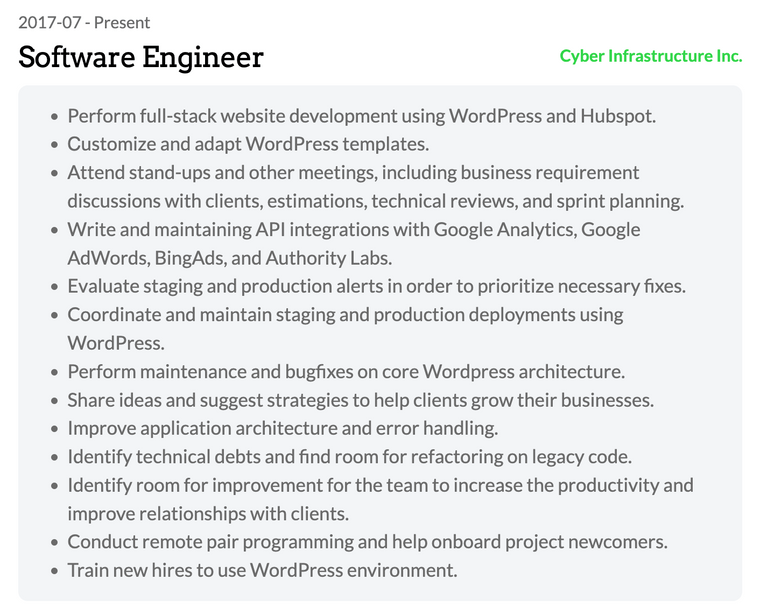
Netherlands Resume Education
Your Education section is less important than your work experience, but it is still important. This section is where you can list your most important degrees or certificates.
List degrees in reverse-chronological order, with your most recent at the top. For each item, be sure to include the:
- Degree name
- School name
- Graduation month
In most cases, a larger description of each degree is not needed. However, if you are a student or recent graduate, you may need to add details of your education in order to fill out your resume. If this is the case, you can include information about your GPA, relevant classwork, relevant projects, or even relevant extracurriculars.

Netherlands Resume Skills
A Skills section is a great opportunity to efficiently display your most impressive and most relevant skills. It is a distinct section where you can provide a curated selection of the competencies that will make you a great choice for the job. The Skills section isn’t mandatory, but a great Skills section can be what lands you the interview.
If you are writing a reverse-chronological resume, your Skills section can be relatively short. Simply list skills in a bulleted list. Make sure the most relevant skills are at the top of the list where they can be seen.
If you are writing a combination or skills-based resume, you can make each skill a heading and provide examples or explanations of each skill in a bulleted list underneath. This will make your skills section much longer, and allow you to go into more detail. If you are writing a skills-based resume, you may want to position your Skills section above your Work Experience section.
At VisualCV, you can even add a strength rating to each skill for some visual flair.
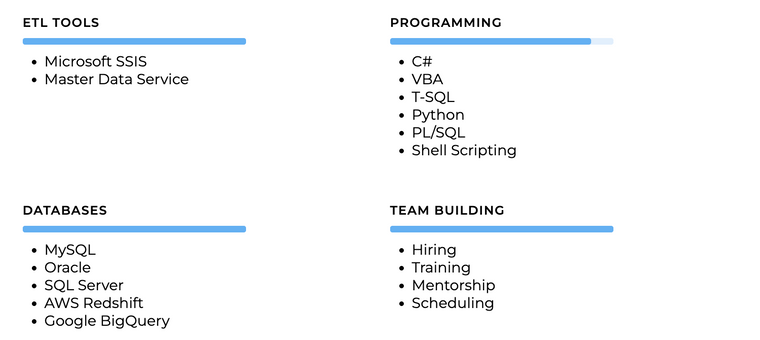
Netherland Resume Extracurriculars
If you belong to any groups or clubs outside of work, you may want to include them in an Extracurriculars of Interests section. Dutch employers appreciate workers who are involved in their community and have interests outside of work.
However, it’s important to make sure anything you include in this section is appropriate and impressive. Try to keep it to activities that demonstrate initiative and leadership, such as belonging to a sports team, volunteering at a local organization, or holding a leadership role in a professional club.
Other sections
While the sections above are enough for most people to write a great Netherlands resume, there may be other sections that will assist your job search. Additional resume sections might include:
- Publications: If you have published any research papers or articles, a Publications section may be useful.
- Portfolio: Either linking out to a Portfolio or listing titles and descriptions of key projects can be an asset in certain industries.
- Memberships: If you belong to any professional organizations or impressive clubs, you may want to include this in your resume.
- Volunteering Experience: Volunteering experience can show not only that you have professional experience, you are willing to donate your time to a cause you believe in.
- Certifications: If a particular license or certificate does not quite fit into your Education section, like a forklift license or a management certificate, you may want to include a separate section for your certifications.
Netherlands Resume Template
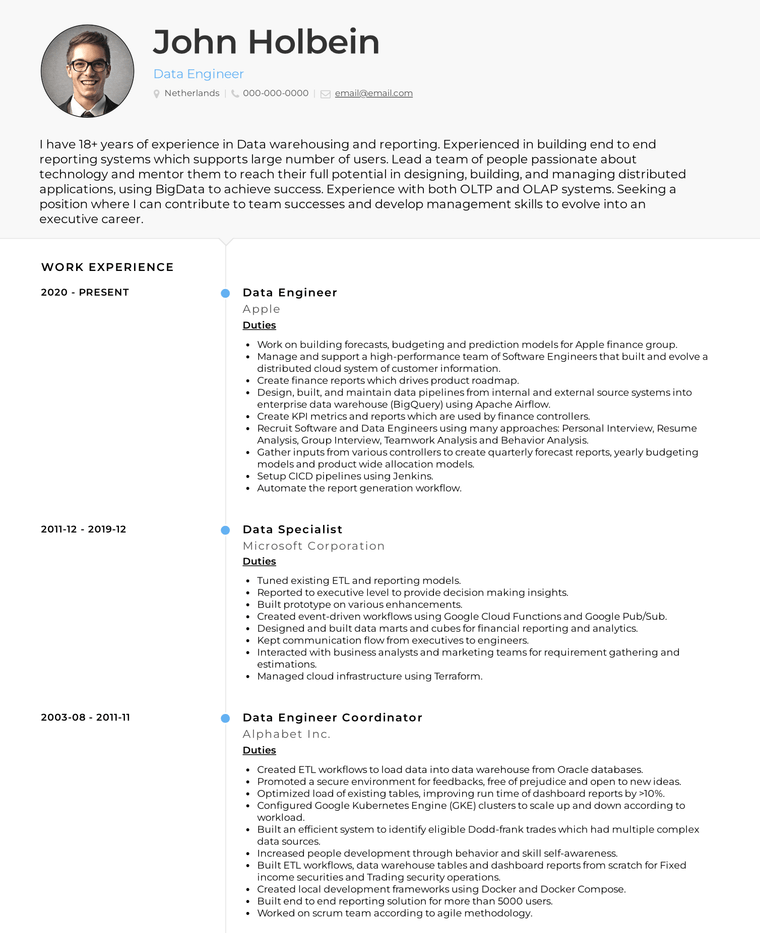
Copyright ©2025 Workstory Inc.